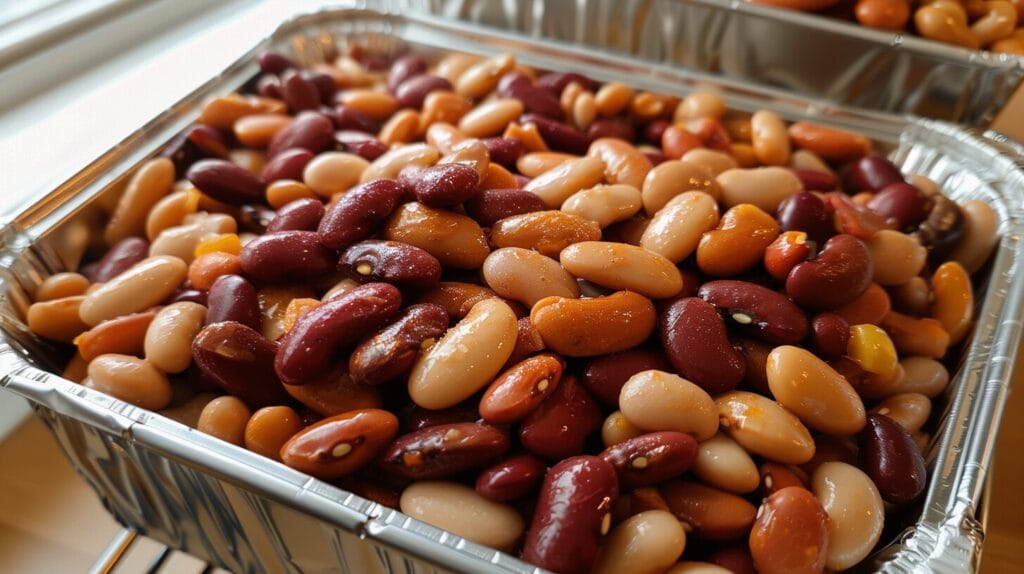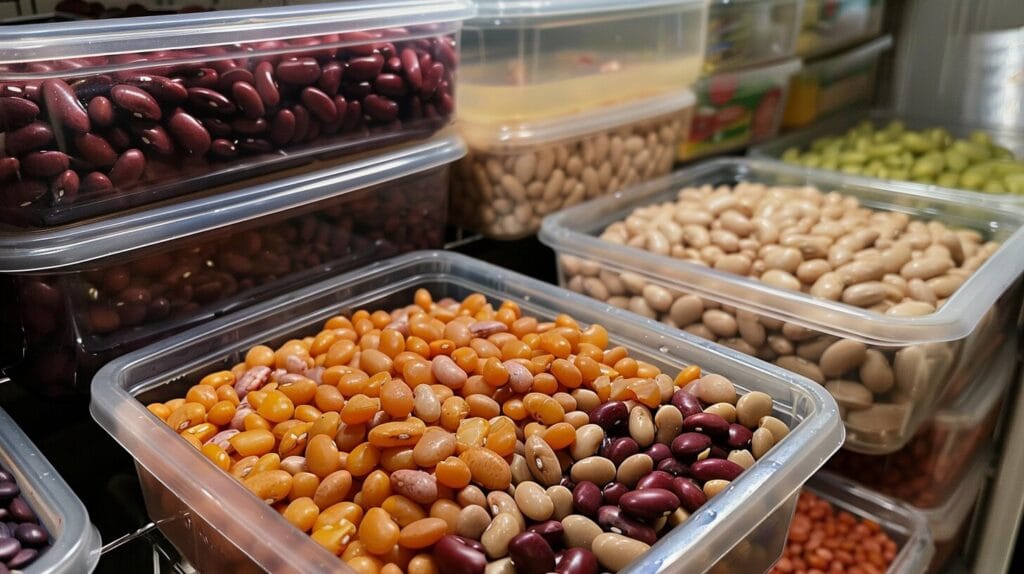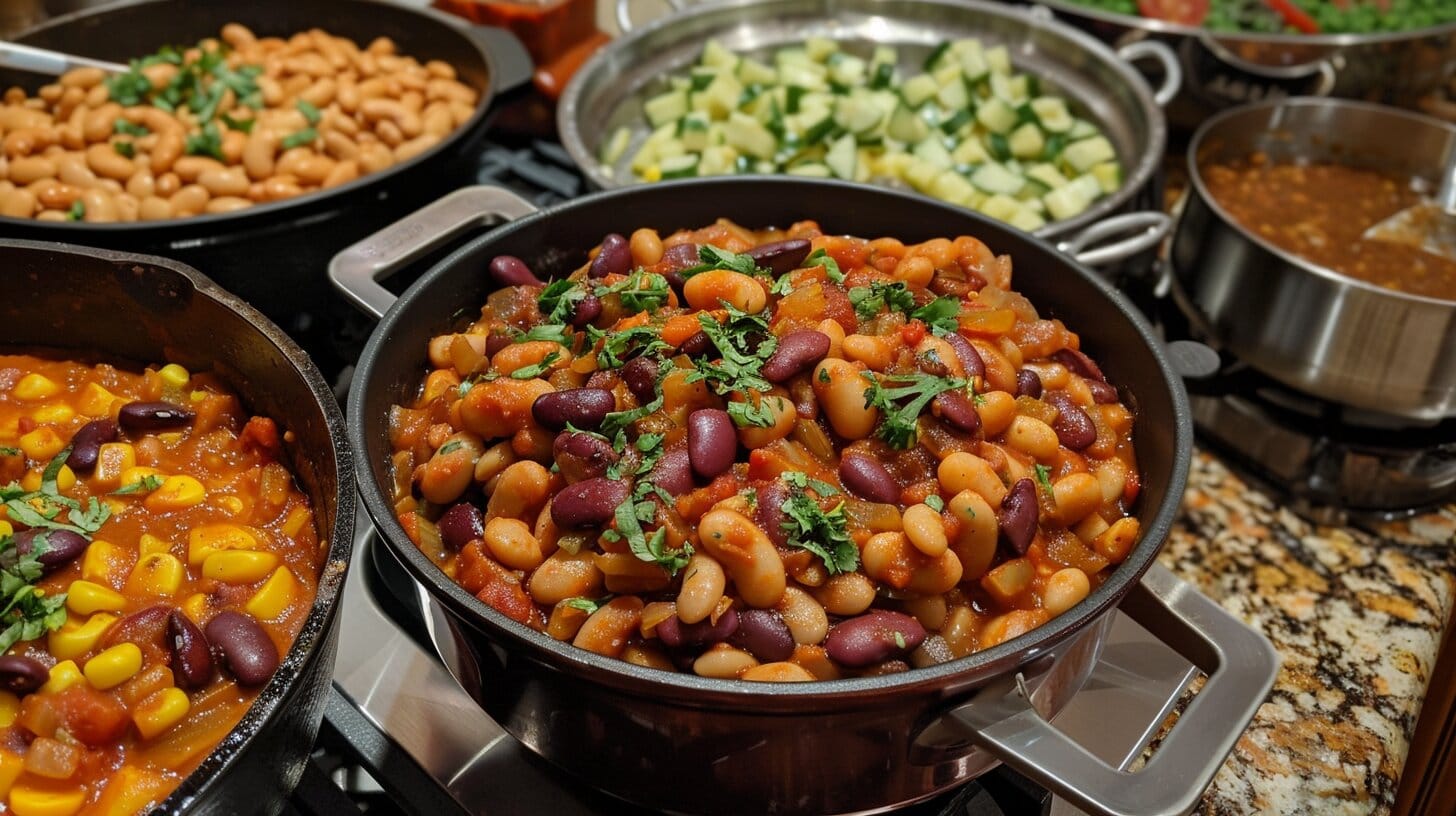Table of Contents
Beans are a versatile, nutritious, and budget-friendly food. Whether you love black beans in burritos, kidney beans in chili, or white beans in a hearty soup, they’re a staple in many kitchens. But how long can you safely keep them in the fridge? You might wonder, “Can you eat beans after 7 days in the fridge?” This issue is vital for ensuring food safety and eliminating waste production.
In this article, we’ll dive into the shelf life of cooked beans, how to spot signs of spoilage, and tips for proper storage. By the end, you’ll clearly understand whether those beans in your fridge are safe to eat or should head to the compost bin.
Let’s get started by understanding how long cooked beans typically last and what factors can affect their freshness.
How Long Do Cooked Beans Last in the Fridge? – Can You Eat Beans After 7 Days in the Fridge?

Cooked beans generally last between 3 to 5 days in the refrigerator if stored properly. but Cooked beans generally last 3 to 5 days in the refrigerator if stored properly. But can you eat beans after 7 days in the fridge? While they might look fine, the risk of bacterial growth increases significantly after the 5-day mark. Eating beans in the refrigerator for over a week could lead to foodborne illness.
Factors That Affect How Long Beans Last in the Fridge
Several factors determine whether beans stay fresh longer or spoil faster:
- Storage Temperature: Beans should always be stored at 40°F (4°C) or lower. Warmer temperatures accelerate spoilage.
- Airtight Containers: Proper containers can extend the shelf life of beans by preventing exposure to air and bacteria.
- Moisture Levels: Excess moisture can lead to mold and spoilage. Always drain beans before refrigerating.
Can You Eat Beans After 7 Days in the Fridge if They Look Fine?
Even if the beans appear and smell normal, eating beans after 7 days in the fridge is not recommended. Harmful bacteria such as Listeria and Salmonella can grow without visible signs, making consumption unsafe.
For the safest practice, consume cooked beans within 5 days or freeze them immediately for more extended storage.
Signs of Spoiled Beans – Can You Eat Beans After 7 Days in the Fridge?

Can you eat beans after 7 days in the fridge? The best way to decide is by checking for signs of spoilage. Even if adequately stored, beans can spoil silently, sometimes without obvious visual cues. Here’s how to know if your beans have gone bad.
Visual Signs – Can You Eat Beans After 7 Days in the Fridge If They Look Normal?
Even if beans look fine after 7 days, that doesn’t mean they’re safe to eat. However, apparent signs like:
- Mold or White Fuzz on the surface
- Discoloration (gray, green, or dark patches)
- Excess Liquid or Sliminess
These are clear indicators that the beans should be discarded. If you notice any of these, do not eat them.
Smell and Texture – Can You Trust Beans After 7 Days in the Fridge?
Spoiled beans often develop a sour, rancid, or ammonia-like smell. A firm or unusual odor is a red flag even if the beans pass the visual test. Additionally, if the beans feel sticky or slimy, it’s a sign of bacterial growth.
Taste Test – Can You Eat Beans After 7 Days if They Taste Normal?
Tasting beans after 7 days is risky and should be avoided unless you’ve carefully checked for other spoilage signs. If the beans have been in the fridge for longer than 5 days, it’s best to discard them – even if they pass a taste test.
Recognizing these signs early can avoid potential foodborne illnesses and keep your meals safe. Firm their freshness. However, this is a last resort. If you’re in doubt, it’s safer to throw them out.
Can You Eat Beans After 7 Days in the Fridge?
Is It Safe?
The straightforward answer is no – eating beans in the fridge for over 7 days is not recommended. Most cooked foods, including beans, risk developing harmful bacteria after 5 days, even if stored properly. While they might look and smell fine, bacteria like Listeria and E. coli can grow without visible signs of spoilage.
Risks of Eating Old Beans
Consuming beans stored for too long can lead to food poisoning. Symptoms may include:
- Nausea
- Vomiting
- Diarrhea
- Stomach cramps
- In severe cases, foodborne illness can cause dehydration and require medical attention.
Even reheating beans thoroughly won’t eliminate all toxins produced by bacteria. Some bacteria, like Staphylococcus aureus, can survive high temperatures.
How to Properly Store Cooked Beans – Can You Eat Beans After 7 Days in the Fridge?
Best Practices for Refrigerating Cooked Beans
To extend the life of your cooked beans:
- Cool Beans Quickly: Let beans cool to room temperature within two hours after cooking.
- Store in Airtight Containers: This prevents bacteria from entering and slows spoilage.
- Label and Date: Mark the storage date to track their stay in the fridge.
Storage Containers
Choose containers that are:
- Glass or BPA-Free Plastic
- Leakproof and Airtight
- Shallow (to allow for faster cooling)
Avoid leaving beans in the pot or uncovered dishes as they can absorb fridge odors and spoil faster.
Freezing for Long-Term Use
For beans you won’t eat within five days, freezing is the best option.
- Portion beans into freezer bags or small containers.
- Freeze in single servings to avoid thawing large amounts at once.
- Beans can last up to 6 months in the fridge.
Health Risks of Eating Spoiled Beans
Food Poisoning from Spoiled Beans
Spoiled beans can harbor harmful bacteria and toxins that lead to foodborne illnesses. The most common culprits are:
- Clostridium perfringens – Causes abdominal cramps and diarrhea within 6 to 24 hours.
- Bacillus cereus – Produces toxins that lead to nausea and vomiting.
- Salmonella – Causes fever, vomiting, and digestive issues.
Eating spoiled beans, even if reheated, can result in these symptoms, as some toxins survive cooking temperatures.
Bacterial Growth and Mold
For too long, beans left in the fridge may develop mold or pathogenic bacteria. Mold spores are visible, but bacteria like E. coli or Listeria can thrive without noticeable signs. Spoiled beans should be discarded immediately to avoid cross-contamination with other foods.
Digestive Issues
Even if the beans are not dangerously spoiled, older beans can cause digestive discomfort. Fermented beans produce gases and may cause bloating, cramps, or diarrhea.
Tips for Extending Bean Shelf Life
Batch Cooking and Storage
- Cook in Smaller Batches – Prepare smaller portions you can eat within 3 to 4 days.
- Use Fresh Ingredients – Beans cooked with fresh, quality ingredients last longer.
- Separate Portions – Divide cooked beans into single servings to avoid reheating the entire batch multiple times.
Reheating Safely
- Reheat beans to at least 165°F (74°C) to kill surface bacteria.
- Use a microwave-safe dish or stovetop to ensure even heating.
- Avoid reheating more than once. Repetitive reheating could lead to the growth of bacilli.
Health Risks of Eating Beans After 7 Days in the Fridge – What Can Happen?
Food Poisoning
One of the primary dangers of eating old beans is food poisoning. Even if beans look fine, bacteria such as Salmonella, Clostridium perfringens, and Listeria can thrive in cooked foods stored too long. Symptoms can develop within hours and may last for days.
Bacterial Growth
Bacteria multiply rapidly between 40°F and 140°F, often called the danger zone. After 5 to 7 days, cooked beans stored in the fridge may harbor dangerous bacteria levels, even if refrigerated consistently.
Mold Concerns
In some cases, beans may develop visible mold. While some molds are harmless, others produce mycotoxins, which can cause allergic reactions, respiratory issues, and digestive problems. If you notice mold, you should throw out all of the batch.
Tips for Extending Bean Shelf Life
Batch Cooking and Storage
To reduce waste and extend the life of your beans:
- Cook in Smaller Batches: Only prepare the amount you’ll eat in 3 to 4 days.
- Freeze Leftovers: Freeze portions right after cooling. This locks in freshness and prevents spoilage.
- Divide into Smaller Portions: Separate beans into single-serve containers to avoid repeated thawing and refreezing.
Reheating Safely
When reheating beans:
- Heat thoroughly to 165°F (74°C).
- Stir beans to ensure even heating.
- Make sure to heat the portion you intend to consume.
Avoid reheating beans multiple times, as this can promote bacteria growth.
What to Do with Leftover Beans – Can You Eat Beans After 7 Days in the Fridge in New Recipes?
Leftover beans are incredibly versatile and can quickly transform into new, delicious meals. Instead of letting them go to waste, repurposing them into creative dishes that add flavor and nutrition to your weekly menu. Here are some tasty and practical ideas for using up those extra beans.
1. Make Hearty Bean Salads – Can You Eat Beans After 7 Days in the Fridge?
Toss leftover beans into a salad for a quick, protein-packed meal. Combine them with fresh vegetables, grains, and a light vinaigrette.
Ideas:
- Black beans with corn, avocado, and cherry tomatoes
- Chickpeas with cucumber, feta, and lemon dressing
- White beans with arugula, sun-dried tomatoes, and olive oil
2. Add to Soups and Stews – Can You Eat Beans After 7 Days in the Fridge?
Beans are a perfect addition to soups, making them heartier and more filling. Stir leftover beans into vegetable, chicken, or beef soups.
Ideas:
- Add kidney beans to chili for extra texture
- Mix white beans into minestrone
- Use lentils in curry or vegetable stews
3. Whip Up Bean Dips and Spreads – Can You Eat Beans After 7 Days in the Fridge?
Beans blend beautifully into dips that pair well with chips, bread, or veggies. A quick blend with a few seasonings can turn them into a tasty snack or appetizer.
Ideas:
- Blend chickpeas for hummus
- Puree black beans with garlic, lime, and cumin for a dip
- Make white bean and rosemary spread for sandwiches
4. Make Veggie Burgers or Patties
Leftover beans can form the base for homemade veggie burgers. Mash them, mix them with breadcrumbs and spices, and form patties for grilling or baking.
Ideas:
- Black bean burgers with cumin and paprika
- Lentil patties with herbs and carrots
- Kidney bean burgers with onion and garlic
5. Incorporate into Breakfast
Beans aren’t just for lunch or dinner – they can add protein and flavor to your morning routine.
Ideas:
- Add black beans to scrambled eggs or omelets
- Use pinto beans in breakfast burritos
- Top toast with white beans and avocado
6. Create Tacos, Burritos, and Quesadillas
Leftover beans make excellent fillings for Mexican-inspired dishes. Pair them with rice, cheese, and salsa for quick, flavorful meals.
Ideas:
- Black bean and rice burritos
- Refried beans in quesadillas
- Chickpea and sweet potato tacos
7. Use in Pasta and Grain Bowls
Beans add a protein boost to pasta and grain bowls. Mix them with your favorite grains like quinoa, farro, or rice for a balanced meal.
Ideas:
- White beans with pesto pasta
- Black beans with rice and grilled veggies
- Lentils with couscous and roasted vegetables
8. Bake Them in Casseroles
Beans can be layered into casseroles, adding fiber and richness to the dish.
Ideas:
- Add kidney beans to lasagna
- Use white beans in a cheesy vegetable bake
- Mix chickpeas into a shepherd’s pie base
By repurposing leftover beans creatively, you’ll reduce food waste and enjoy healthy, satisfying meals throughout the weekdays!
Frequently Asked Questions (FAQ):
Can You Freeze Beans After Refrigerating Them for a Week?
Freezing beans is best done within 3-5 days of cooking to ensure their safety and quality. If your beans have been sitting in the fridge for over a week, freezing them isn’t advisable. While freezing halts bacterial growth, it does not eliminate bacteria that may have already developed. For a guide on safely storing beans and maintaining freshness, check out How Long Will Bean Salad Last in the Fridge?
How Do You Know If Beans Have Gone Bad?
Watch for typical signs such as mold, foul odor, discoloration, or slimy texture. Even if beans appear normal, but you feel uncertain, it’s better to err on caution. Try this Dense Bean Salad Recipe for Busy Weeknights if you’re looking for recipes to use up beans before they spoil.
Can Reheating Kill Bacteria in Old Beans?
Reheating beans may kill some bacteria, but toxins from bacteria like Staphylococcus aureus survive high temperatures. It’s safest to discard beans over 5-7 days old. For more on how bean dishes last, read Why Should You Eat a Dense Bean Salad Today?
How Long Do Canned Beans Last Once Opened?
After opening, canned beans last 3-4 days in the fridge if stored in an airtight container. Avoid leaving them in the can, as this can shorten their shelf life. If you frequently use canned beans, explore creative ways to use leftovers with this Low Sodium Chili Recipe.
Do Some Beans Spoil Faster Than Others?
Soft beans, such as black beans and lentils, spoil faster than firmer varieties like chickpeas. Follow the 3-5 day rule for best results regardless of type. Proper storage can extend their shelf life. Try a Chickpea and Green Bean Recipe to preserve leftover beans.
Is It Better to Store Beans Dry or Cooked?
Dry beans last years when stored correctly, while cooked beans spoil quickly. For convenience, consider batch cooking and freezing portions. For additional inspiration, see how to incorporate beans into creative dishes like this Creamy Mac and Cheese Recipe.
Conclusion
Regarding the question – Can you eat beans after 7 days in the fridge? The answer is clear: avoiding eating beans stored for that long is best. Cooked beans are generally safe for 3 to 5 days in the refrigerator, but the risk of spoilage and harmful bacterial growth increases significantly beyond this window. While beans might appear fine on the surface, bacteria like Listeria, Salmonella, and E. coli can thrive in cooked foods stored too long, posing a risk of food poisoning.
It’s easy to underestimate how quickly bacteria multiply, especially in moist, protein-rich foods like beans. Even if reheated, some toxins bacteria produce cannot be destroyed by heat, making consumption risky. Food safety guidelines emphasize the importance of proper storage and timely consumption.
Plan ahead to make the most of your beans without risking your health. Freeze leftover beans in small portions if you’re unlikely to eat them within a few days. This not only preserves their quality but also prevents unnecessary waste. If you often find yourself with extra beans, consider incorporating them into new dishes such as soups, salads, dips, or casseroles to give them a second life in your meals.
Ultimately, staying mindful of how long cooked foods sit in the fridge is crucial to protecting your health. When in doubt, it’s safer to discard questionable food rather than risk the consequences of foodborne illness. Following these tips and best practices, you can confidently enjoy beans while keeping your kitchen safe and your meals delicious.
